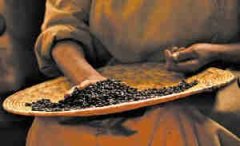The technology of stir-fried coffee beans the basic knowledge of coffee beans

Use wind and vibration to remove ash / soil / pebbles / metal and other impurities from coffee beans. The cleaning process is generally carried out on special machinery, or manual screening can be used. Then let the coffee beans pass through sieves of different sizes and grade them according to size. If possible, a colorimeter can also be used to monitor immature coffee beans and pick out coffee beans that are too light or too dark. Use ultraviolet light to select and remove rotten coffee beans.
two。 Deployment
Before roasting, different varieties of coffee are blended. By adding different varieties and producing areas of coffee, various flavors and ingredients are combined to make the coffee have a specific flavor and ensure the consistency of coffee quality.
In order to find coffee suitable for different tastes, coffee can be added in a certain proportion according to its origin to achieve the best results. Generally speaking, wet-treated Arabica coffee tastes sour and fragrant, while natural Arabica coffee tastes average. Robasta coffee is strong, bitter and earthy coffee from Kenya and Tanzania, with a distinct sweet and sour taste. Different mixtures can produce unique characteristics.
3. Roasting
When the prepared coffee beans are treated in the dry state, the structure and composition of the coffee beans undergo significant chemical and physical changes, resulting in the darkening of the coffee beans and the unique aroma of roasted coffee.
At the beginning, the roasting temperature should rise to more than 150C. Through a series of Maillard reactions and Strecker decomposition, proteins and sugars in coffee beans react to form substances with flavor and color. Several main aroma substances in coffee are formed at this time. The color of coffee beans is related to the roasting temperature. The higher the temperature, the darker the color. After roasting 8min~12min, the water in the coffee beans evaporates completely, and the quality of the coffee beans is reduced by 20%, but the volume is increased by 60%.
4. Cooling
Roasted coffee beans must be cooled quickly, generally using cold air blast cooling, but also using water cooling process.
5. Packing
Roasted coffee products also require strict packaging and suitable storage environment. As roasted coffee products are easily oxidized, the packaging and storage of roasted coffee products are even more important.
Roasted coffee products that have just come out of the production process have a beautiful flavor, which should also be the fresh characteristics of roasted coffee products. But before long, these characteristics disappeared one after another. In a general climate, the deterioration rate of roasted coffee products often depends on packaging and storage conditions.
The function of packaging is to avoid the attack of air moisture on roasted coffee products. The relative humidity of the air is sometimes high and sometimes low, and if roasted coffee products absorb air and water vapor, they can be so serious that they lose the value of the goods. Therefore, the selection of packaging materials and packaging forms is the key to improve the water and air resistance of products.
Another function of packaging is to permanently protect the aroma of roasted coffee products. The fifth is to protect the aroma of roasted coffee products from escaping into the air, and the second is to stop the pollution of all unpleasant smells in the external environment. Fresh roasted coffee products with strong aroma will weaken after being placed for a period of time. First of all, volatile aromatic substances spread from the products to the space, and roasted coffee products will also catch the unpleasant smell around them. Therefore, high-quality roasted coffee products are mostly sealed packaging to maintain its aroma.
Note: quality and safety problems that are easy to occur
1. The unreasonable setting of time and temperature during coffee roasting leads to the decline of quality index.
In the process of roasting, coffee beans undergo a series of physical and chemical changes in the process of high temperature treatment, which determines their taste and flavor quality. if the roasting temperature is increased, although the roasting speed can be increased and the color of coffee beans can be darkened, it can not make Maillard reaction occur fully, and the formation of flavor substances of coffee is limited.
two。 Improper storage and packaging of the products lead to the decline of coffee flavor and unpleasant smell.
Freshly roasted coffee should be packaged as soon as possible. If it comes into contact with air, it will oxidize and lose its unique flavor. Packaging can also prevent roasted coffee from catching an unpleasant smell around it. Therefore, roasted coffee products are mostly sealed packaging to maintain its flavor.
At the same time, coffee beans will produce a certain amount of carbon dioxide smell after roasting, so, if stored improperly, it will cause volume expansion and damage the packaging bag, so we should try to use the composite packaging bag with valve device. The valve is an one-way valve that not only prevents air from entering, but also allows the gas produced by coffee to be discharged smoothly. Of course, metal cans are more ideal packaging materials.
Important Notice :
前街咖啡 FrontStreet Coffee has moved to new addredd:
FrontStreet Coffee Address: 315,Donghua East Road,GuangZhou
Tel:020 38364473
- Prev

Matters needing attention in the preservation of coffee beans
The preservation of coffee beans is one of the controllable factors in the taste of a cup of coffee. Matters needing attention in preservation: 1. Try to buy fresh coffee, usually one-way valve packaging, please pay attention to the production date on the packaging, of course, the closer to the purchase date, the better. It is recommended to buy half a pound of packaging, even if you need a pound of beans. Because it can prolong the shelf life of coffee properly without opening the package. two。 open
- Next

Coffee is made in this way, the production process of coffee beans.
The women picked out the coffee beans that were not fully roasted. The workers poured the coffee beans into the roaster and poured the roasted coffee beans into the plate to cool down. There is a place in Ethiopia called Kafa. Local residents have found that cattle and sheep become excited and powerful after eating a plant that grows small red beans. Later, people began to pick it and grow it consciously, using Kafa as food and drink.
Related
- Detailed explanation of Jadeite planting Land in Panamanian Jadeite Manor introduction to the grading system of Jadeite competitive bidding, Red bid, Green bid and Rose Summer
- Story of Coffee planting in Brenka region of Costa Rica Stonehenge Manor anaerobic heavy honey treatment of flavor mouth
- What's on the barrel of Blue Mountain Coffee beans?
- Can American coffee also pull flowers? How to use hot American style to pull out a good-looking pattern?
- Can you make a cold extract with coffee beans? What is the right proportion for cold-extracted coffee formula?
- Indonesian PWN Gold Mandrine Coffee Origin Features Flavor How to Chong? Mandolin coffee is American.
- A brief introduction to the flavor characteristics of Brazilian yellow bourbon coffee beans
- What is the effect of different water quality on the flavor of cold-extracted coffee? What kind of water is best for brewing coffee?
- Why do you think of Rose Summer whenever you mention Panamanian coffee?
- Introduction to the characteristics of authentic blue mountain coffee bean producing areas? What is the CIB Coffee Authority in Jamaica?

